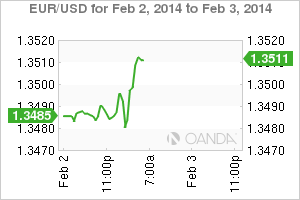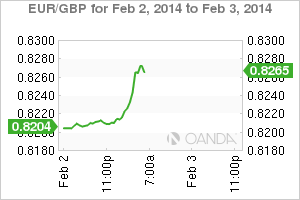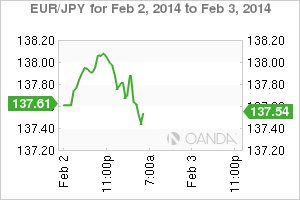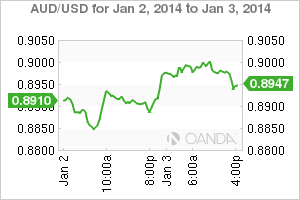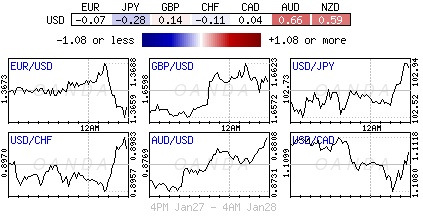This is an event-laden week for capital markets, with a few central banks expected to bare teeth when it comes to their own monetary policy decisions (RBA, BoE and ECB). Already in overnight action, the holiday-thinned market in Asia has been trading with a negative slant. They have not been helped by the world's second largest economy official PMI coming in at a six-month low (50.5) and their non-manufacturing at a two-year low (53.3). So far this year, the accumulation of a number of softer Chinese reports is beginning to worry more investors, as they hover over that sell button. Obviously regional questions have again pressurized the Nikkei - shaving another -2%, following on from the Dow's -1% loss last Friday.
Within the forex space, the yen and the dollar continue to hold onto that strong safety bid, while the 18-member single currency trades within sight of its two-month low. The Emerging Market currencies continue to dominate risk sentiment – as the Turkish lira (TRY) and South African (ZAR) remain under selling pressure. To bring a fitting end to what's expected to be a volatile forex week will be the North Americas January's job's report. Both Canada and the US December's headline left a nasty aftertaste, this time the market is ruling that out. Is the market going to be caught flatfooted like last time?
The investors favorite traded currency pair, the EUR/USD, does not get intimidated that easily. Four-year ago it took the threat of a Greek sovereign default to bring the single currency to 'one' knee. A couple of years later it was an inconclusive Greek election outcome that temporarily crippled its progress. Today, it’s the threat of Eurozone deflation and what Draghi and company are willing to do about it that has the EUR on the back foot. With inflationary pressures subsiding in January for the Euro-zone, investors are already beginning to price in an easing bias as they expect the ECB to act at some point down the road. The majority so far do not expect any direct ECB action come Thursday, however, the ECB have know to surprise – last Novembers rate cut was outside the ECB's quarterly forecast round.
A percentage of the market is anticipating the ECB to cut its main refinancing rate by -15bp to a record low of +0.10%, and the interest rate on the deposit facility by -10bp to negative territory come Thursday. Even if Draghi and his fellow policy makers do not carry through with these actions, the risks to the EUR still remain very much uneven. The mere fact that Draghi and company will have to remain dovish (for low inflation sake) and the potential indication of a policy response (in the future) should be held over to Draghi's press conference.
The risk of a rate cut by the ECB is not the only concern for the single-currency. The rumor that the Bundesbank might support stopping the "weekly sterilization" of the ECB's legacy bond portfolio is also weighing on the currency. That is draining the excess liquidity that is pumped into the system by the ECB. Using a sterile policy has allowed "the ECB to claim that no Fed style QE program was ever initiated." To discontinue would increase market liquidity initially and provide some downward pressure on money market products. More importantly, market perception of QE may change – investors "could interpret it as a sign that QE is less controversial to Euro-policy makers than previously assumed." No matter what, Draghi and company will have to maintain their fancy footwork to keep the EUR's fall within an orderly trading range.
Before the EUR's center stage performance on Thursday, the RBA and governor Stevens are this week's first central bank act to show their hand later this evening. While the majority of investors do not expect the Governor to change the current cash rate (+2.50%), there is a belief that the RBA could possibly remove any residual easing bias in its policy statement. If so, this will immediately lead the rates market to begin pricing in a "future" rate hike. This year was always going to be dominated by 'rate divergence' – there is no need to "follow thy leader anymore." The 'new' leader is now Janet Yellen at the Fed. Policy makers are prepping themselves to turn off or slow down their own liquidity taps without disturbing their own country's tenuous growth. The Australian economy has shown signs of recovery of late, with record low interest rates continuing to provide the spark for the housing sector. It’s the mining sector that continues to drag on the economy. Obviously, the AUD 's price fall over the last 12-months has been able to somewhat artificially cushion their economy to threats.
This article is for general information purposes only. It is not investment advice or a solution to buy or sell securities. Opinions are the authors — not necessarily OANDA’s, its officers or directors. OANDA’s Terms of Use and Privacy Policy apply. Leveraged trading is high risk and not suitable for all. You could lose all of your deposited funds.
Recommended Content
Editors’ Picks

RBA keeps interest rate on hold at 4.1% as expected
The Reserve Bank of Australia announced on Tuesday that it left the Official Cash Rate unchanged at 4.1% after concluding its April monetary policy meeting. The decision aligned with the market expectations.

Gold stands tall as tariff jitters outweigh overbought conditions
Gold price closes in on the $3,150 psychological mark in Asian trading on Tuesday, extending its record rally. Gold buyers eagerly await the US announcement of “reciprocal tariffs” on Wednesday for a fresh directional impetus. In the meantime, tariff updates and top-tier US data will likely keep them entertained.

USD/JPY trades on the backfoot below 150.00 amid trade war fears
USD/JPY edges lower in the Asian session on Tuesday as hawkish BoJ expectations continue to offer some support to the Japanese Yen. Subdued US Dollar price action weighs on the pair. Concerns over Trump's tariffs and its impact on the global economic growth remain a drag on the pair.
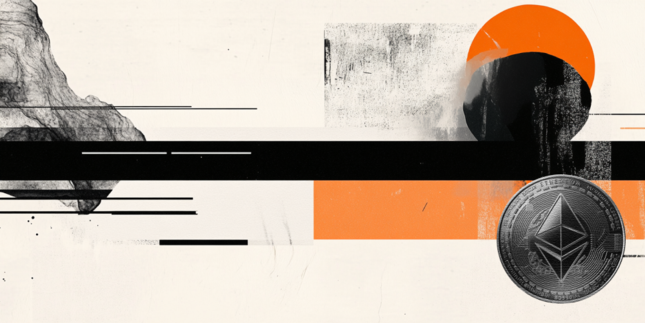
Ethereum: Short-term holders spark $400 million in realized losses, staking flows surge
Ethereum bounced off the $1,800 support on Monday following increased selling pressure from short-term holders and tensions surrounding President Donald Trump's reciprocal tariff kick-off on April 2.

US: Trump's 'Liberation day' – What to expect?
Trump has so far enacted tariff changes that have lifted the trade-weighted average tariff rate on all US imports by around 5.5-6.0%-points. While re-rerouting of trade will decrease the effectiveness of tariffs over time, the current level is already close to the highest since the second world war.

The Best brokers to trade EUR/USD
SPONSORED Discover the top brokers for trading EUR/USD in 2025. Our list features brokers with competitive spreads, fast execution, and powerful platforms. Whether you're a beginner or an expert, find the right partner to navigate the dynamic Forex market.
